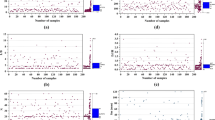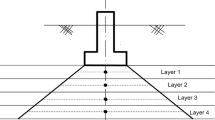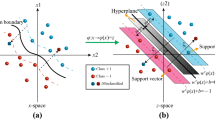Abstract
Because cohesive soil structure is so complicated, settlement modelling is, in some ways, essential. The goal of this study is to identify settlement (\(S_{m}\)) of shallow foundations using newly developed machine learning methods, such as hybridized support vector regression (\(SVR\)) with sine–cosine algorithm (\(SCA\)) and Bat-inspired algorithm (\(BAT\)). Footing width, pressure, geometry, number of standard penetration tests, and footing embedment ratio are among the estimated variables. The application of optimization methods served the objective of identifying the optimal value for the primary variables of the researched model. The SCA–SVR is thought to be the best framework with the highest classification when compared to BAT–SVR and ANFIS–PSO. During the process of learning, the values of \(R^{2}\) and \(MAE\) are 0.9629 and 1.5354, which is preferable to ANFIS–PSO by 0.9025 and 4.92, and 0.9823 and 1.3787 in the evaluating portion, which is superior to ANFIS–PSO at 0.739 and 9.88. By looking at \(PI\) indicator, the SCA–SVR network does better than the BAT–SVR in both the education and evaluating datasets. The SCA–SVR model dropped 0.0262 and 0.0435 points in the education and evaluating data sets, respectively. Likewise, the \(A_{10 - index}\) index exhibits a similar tendency. In conclusion, after analyzing the accuracy and taking into account the definitions, it is completely obvious that the \(SVR\) combined with \(SCA\) can work better than \(BAT\), as well as by literature, that could be referred to as the proposed system in the forecasting model of \(S_{m}.\)


Similar content being viewed by others
Data Availability
Enquiries about data availability should be directed to the authors.
Abbreviations
- PLT:
-
Plate load test
- PMT:
-
Pressure-meter test
- DMT:
-
Dilatometer test
- \(SVR\) :
-
Support vector regression
- \(BAT\) :
-
Bat-inspired algorithm
- \(ANFIS\) :
-
Adaptive neuro fuzzy inference system
- \({S}_{m}\) :
-
Settlement
- \(MAE\) :
-
Mean absolute error
- \({R}^{2}\) :
-
Coefficient of determination
- SPT:
-
Standard penetration test
- CPT:
-
Cone penetration test
- VST:
-
Vane shear test
- \(SCA\) :
-
Sine–cosine algorithm
- \(PSO\) :
-
Particle swarm optimization
- AI:
-
Artificial intelligence
- \(PI\) :
-
Performance index
- \(\mathrm{PCC}\) :
-
Pearson correlation coefficient
- ANN:
-
Artificial Neural Network
References
Aghayari Hir M, Zaheri M, Rahimzadeh N (2022) Prediction of rural travel demand by spatial regression and artificial neural network methods (Tabriz County). J Transp Res
Alkroosh I, Alzabeebee S, Al-Taie AJ (2020) Evaluation of the accuracy of commonly used empirical correlations in predicting the compression index of Iraqi fine-grained soils. Innov Infrastruct Solut 5:1–10
Al-Musawi AA, Alwanas AAH, Salih SQ et al (2020) Shear strength of SFRCB without stirrups simulation: implementation of hybrid artificial intelligence model. Eng Comput 36:1–11
Alwanas AAH, Al-Musawi AA, Salih SQ et al (2019) Load-carrying capacity and mode failure simulation of beam-column joint connection: application of self-tuning machine learning model. Eng Struct 194:220–229
Ashrafian A, Shokri F, Amiri MJT et al (2020) Compressive strength of foamed cellular lightweight concrete simulation: new development of hybrid artificial intelligence model. Constr Build Mater 230:117048
Benemaran RS (2023) Application of extreme gradient boosting method for evaluating the properties of episodic failure of borehole breakout. Geoenergy Sci Eng 226:211837
Benemaran RS, Esmaeili-Falak M (2020) Optimization of cost and mechanical properties of concrete with admixtures using MARS and PSO. Comput Concr 26:309–316. https://doi.org/10.12989/cac.2020.26.4.309
Birid KC, Chahar RS (2019) Measured and predicted settlement of shallow foundations on cohesionless soil. In: Anirudhan IV, Maji VB (eds) Geotechnical applications. Springer, Berlin, pp 3–13
Cristianini N, Shawe-Taylor J (2000) An introduction to support vector machines and other kernel-based learning methods. Cambridge University Press, Cambridge
Das B, Sivakugan N (2007) Settlements of shallow foundations on granular soil—an overview. Int J Geotech Eng 1:19–29
Das BM, Sivakugan N (2018) Principles of foundation engineering. Cengage learning, Boston
Das S, Bhattacharya A, Chakraborty AK (2018) Solution of short-term hydrothermal scheduling using sine cosine algorithm. Soft Comput 22:6409–6427
Esmaeili-choobar N, Esmaeili-falak M, Roohi-hir M, Keshtzad S (2013) Evaluation of collapsibility potential at Talesh, Iran. EJGE 18:2561–2573
Esmaeili-Falak M, Hajialilue-Bonab M (2012) Numerical studying the effects of gradient degree on slope stability analysis using limit equilibrium and finite element methods. Int J Acad Res 4:216–222. https://doi.org/10.7813/2075-4124.2012/4-4/A.30
Esmaeili-Falak M, Sarkhani Benemaran R (2022) Investigating the stress-strain behavior of frozen clay using triaxial test. J Struct Constr Eng 10(1):133–149
Esmaeili-Falak M, Sarkhani Benemaran R (2023) Ensemble deep learning-based models to predict the resilient modulus of modified base materials subjected to wet-dry cycles. Geomech Eng 32:583–600
Esmaeili-Falak M, Katebi H, Javadi A (2018) Experimental study of the mechanical behavior of frozen soils-A case study of tabriz subway. Period Polytech Civ Eng 62:117–125
Esmaeili-Falak M, Katebi H, Vadiati M, Adamowski J (2019) Predicting triaxial compressive strength and Young’s modulus of frozen sand using artificial intelligence methods. J Cold Reg Eng 33:4019007. https://doi.org/10.1061/(ASCE)CR.1943-5495.0000188
Ge D-M, Zhao L-C, Esmaeili-Falak M (2023) Estimation of rapid chloride permeability of SCC using hyperparameters optimized random forest models. J Sustain Cem Mater 12:542–560
Li S, Fang H, Liu X (2018) Parameter optimization of support vector regression based on sine cosine algorithm. Expert Syst Appl 91:63–77. https://doi.org/10.1016/j.eswa.2017.08.038
Maghsoodi V, Atermoghaddam F, Esmaeili-Falak M (2013) Parametric and two dimensional study of seismic behavior of micro pile group in sandy soil. Intl Res J Appl Basic Sci 6:901–909
McCarthy DF, McCarthy DF (1977) Essentials of soil mechanics and foundations. Reston Publishing Company, Reston
Mirjalili S (2016) SCA: a sine cosine algorithm for solving optimization problems. Knowledge-based Syst 96:120–133. https://doi.org/10.1016/j.knosys.2015.12.022
Mohammed M, Sharafati A, Al-Ansari N, Yaseen ZM (2020) Shallow foundation settlement quantification: application of hybridized adaptive neuro-fuzzy inference system model. Adv Civ Eng 2020:1–14
Moradi G, Hassankhani E, Halabian AM (2020) Experimental and numerical analyses of buried box culverts in trenches using geofoam. Proc Inst Civ Eng Eng 175(3):311–322
Naderpour H, Nagai K, Haji M, Mirrashid M (2019) Adaptive neuro-fuzzy inference modelling and sensitivity analysis for capacity estimation of fiber reinforced polymer-strengthened circular reinforced concrete columns. Expert Syst 36:e12410
Noori R, Abdoli MA, Ghasrodashti AA, Jalili Ghazizade M (2009) Prediction of municipal solid waste generation with combination of support vector machine and principal component analysis: a case study of Mashhad. Environ Prog Sustain Energy an off Publ Am Inst Chem Eng 28:249–258
Poorjafar A, Esmaeili-Falak M, Katebi H (2021) Pile-soil interaction determined by laterally loaded fixed head pile group. Geomech Eng 26:13–25. https://doi.org/10.12989/gae.2021.26.1.013
Rout B, Pati BB, Panda S (2018) Modified SCA algorithm for SSSC damping controller design in power system. ECTI Trans Electr Eng Electron Commun 16:46–63
Sarkhani Benemaran R, Esmaeili-Falak M, Javadi A (2022) Predicting resilient modulus of flexible pavement foundation using extreme gradient boosting based optimised models. Int J Pavement Eng. https://doi.org/10.1080/10298436.2022.2095385
Sarkhani Benemaran R, Esmaeili-Falak M, Katebi H (2022b) Physical and numerical modelling of pile-stabilized saturated layered slopes. Proc Inst Civ Eng Geotech Eng 175:523–538. https://doi.org/10.1680/jgeen.20.00152
Shahin MA (2003) Use of artificial neural networks for predicting settlement of shallow foundations on cohesionless soils/Mohamed A. Shahin.
Sharafati A, Haghbin M, Motta D, Yaseen ZM (2021) The application of soft computing models and empirical formulations for hydraulic structure scouring depth simulation: a comprehensive review, assessment and possible future research direction. Arch Comput Methods Eng 28:423–447
Shaw B (2019) Comparison of SCA-optimized PID and P&O-based MPPT for an off-grid fuel cell system. In: Nayak A, Abraham A, Murali KB, Chandra Sekhar GT, Kumar Das A (eds) Soft computing in data analytics. Springer, Berlin, pp 51–58
Shi X, Yu X, Esmaeili-Falak M (2023) Improved arithmetic optimization algorithm and its application to carbon fiber reinforced polymer-steel bond strength estimation. Compos Struct 306:116599. https://doi.org/10.1016/j.compstruct.2022.116599
Vapnik VN (1999) An overview of statistical learning theory. IEEE Trans Neural Netw 10:988–999
Vapnik V, Golowich S, Smola A (1996) Support vector method for function approximation, regression estimation and signal processing. Adv Neural Inf Process Syst 9:281–287
Yang X-S (2010) A new metaheuristic bat-inspired algorithm. In: Pelta DA, Krasnogor N, Dumitrescu D, Chira C, Lung R (eds) Nature inspired cooperative strategies for optimization (NICSO 2010). Springer, Berlin, pp 65–74
Yang C, Feng H, Esmaeili-Falak M (2022) Predicting the compressive strength of modified recycled aggregate concrete. Struct Concr 23(6):3696–3717
Yu P-S, Chen S-T, Chang I-F (2006) Support vector regression for real-time flood stage forecasting. J Hydrol 328:704–716
Zhang Z, Rao F-R, Ye G-B (2020) Design method for calculating settlement of stiffened deep mixed column-supported embankment over soft clay. Acta Geotech 15:795–814
Funding
The authors have not disclosed any funding.
Author information
Authors and Affiliations
Corresponding author
Ethics declarations
Conflict of interest
The authors have not disclosed any competing interests.
Additional information
Publisher's Note
Springer Nature remains neutral with regard to jurisdictional claims in published maps and institutional affiliations.
Rights and permissions
Springer Nature or its licensor (e.g. a society or other partner) holds exclusive rights to this article under a publishing agreement with the author(s) or other rightsholder(s); author self-archiving of the accepted manuscript version of this article is solely governed by the terms of such publishing agreement and applicable law.
About this article
Cite this article
Wan, X. Predicting the Settlement of Shallow Foundation Using Metaheuristic SVR Approaches. Geotech Geol Eng 41, 4795–4805 (2023). https://doi.org/10.1007/s10706-023-02547-w
Received:
Accepted:
Published:
Issue Date:
DOI: https://doi.org/10.1007/s10706-023-02547-w




